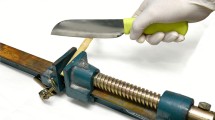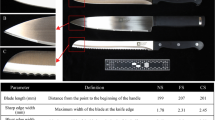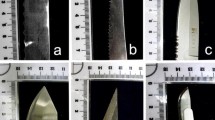Abstract
Sharp force traumas are frequently encountered in stabbing crime victims. During an examination, the properties of cutting marks in bones are compared with the properties of suspect tools, particularly knives. Therefore, the variation and specificity of knife and cutting mark properties must be known. This article provides the variability and specificity of a set of knife blade and cutting mark properties. Plain and serrated knives are used to create experimental cutting marks in porcine ribs, knife properties are derived from surface acquisitions of the blades and mark properties from Micro-CT data. We consider two conditions, automated stabbing using a motorized stage and manual stabbing. In addition, we study the influence of maceration on marks. For knives, the blade edge angle, blade thickness, and bevel height, and for cutting marks, the shape, the wall angle, the width, and the bevel height are determined and compared. The results show that the relationship between corresponding properties of blades and marks depends on the knife type. For plain knives, the width and wall angle of the marks are dependent on the mark depth and are significantly smaller than the blade properties edge angle and width. For serrated knives, this is not the case. The mark shape only provides slight support for a knife type for marks deeper than the blade bevel height. In conclusion, mark properties are only specific for a particular knife brand and model if the blade properties differ significantly and assuming a specific knife type.












Similar content being viewed by others
Availability of data and material
Data and material can be made available on request.
Code availability
Code can be made available on request.
References
Norman DG, Watson DG, Burnett B, Fenne PM, Williams MA (2018) The cutting edge - Micro-CT for quantitative toolmark analysis of sharp force trauma to bone. Forensic Sci Int 283:156–172. https://doi.org/10.1016/j.forsciint.2017.12.039
Tegtmeyer CE (2012) A comparative analysis of serrated and non-serrated sharp force trauma to bone. Texas State University
Thomsen AH, Hougen HP, Villesen P, Brink O, Leth PM (2019) Sharp force homicide in Denmark 1992–2016. J Forensic Sci. https://doi.org/10.1111/1556-4029.14244
Anonymized self-reference (will be substituted for the final document)
Hunt AC, Cowling RJ (1991) Murder by stabbing. Forensic Sci Int. 52:107–12
Love JC (2019) Sharp force trauma analysis in bone and cartilage: a literature review. Forensic Sci Int 299:119–127. https://doi.org/10.1016/j.forsciint.2019.03.035
Cerutti E, Magli F, Porta D, Gibelli D, Cattaneo C (2014) Metrical assessment of cutmarks on bone: is size important? Leg Med (Tokyo) 16(4):208–213. https://doi.org/10.1016/j.legalmed.2014.03.010
Komo L, Grassberger M (2018) Experimental sharp force injuries to ribs: multimodal morphological and geometric morphometric analyses using micro-CT, macro photography and SEM. Forensic Sci Int 288:189–200. https://doi.org/10.1016/j.forsciint.2018.04.048
González MAM, Yravedra J, González-Aguilera D, Palomeque-González JF, Domínguez-Rodrigo M (2015) Micro-photogrammetric characterization of cut marks on bones. J Archaeol Sci 62:128–142
Capuani C, Guilbeau-Frugier C, Delisle MB, Rouge D, Telmon N (2014) Epifluorescence analysis of hacksaw marks on bone: highlighting unique individual characteristics. Forensic Sci Int 241:195–202. https://doi.org/10.1016/j.forsciint.2014.05.025
Sandras A, Guilbeau-Frugier C, Savall F, Telmon N, Capuani C (2019) Sharp bone trauma diagnosis: a validation study using epifluorescence microscopy. Int J Legal Med 133(2):521–528. https://doi.org/10.1007/s00414-018-1944-z
Thompson TJ, Inglis J (2009) Differentiation of serrated and non-serrated blades from stab marks in bone. Int J Legal Med 123(2):129–135. https://doi.org/10.1007/s00414-008-0275-x
Crowder C, Rainwater CW, Fridie JS (2013) Microscopic analysis of sharp force trauma in bone and cartilage: a validation study. J Forensic Sci 58(5):1119–1126. https://doi.org/10.1111/1556-4029.12180
Shaw KP, Chung JH, Chung FC, Tseng BY, Pan CH, Yang KT et al (2011) A method for studying knife tool marks on bone. J Forensic Sci 56(4):967–971. https://doi.org/10.1111/j.1556-4029.2011.01741.x
Nogueira L, Quatrehomme G, Rallon C, Adalian P, Alunni V (2016) Saw marks in bones: a study of 170 experimental false start lesions. Forensic Sci Int 268:123–130. https://doi.org/10.1016/j.forsciint.2016.09.018
Kooi RJ, Fairgrieve SI (2013) SEM and stereomicroscopic analysis of cut marks in fresh and burned bone. J Forensic Sci 58(2):452–458. https://doi.org/10.1111/1556-4029.12050
Bonney H (2014) An investigation of the use of discriminant analysis for the classification of blade edge type from cut marks made by metal and bamboo blades. Am J Phys Anthropol 154(4):575–584. https://doi.org/10.1002/ajpa.22558
Bolliger SA, Kneubuehl BP, Thali MJ, Eggert S, Siegenthaler L (2016) Stabbing energy and force required for pocket-knives to pierce ribs. Forensic Sci Med Pathol 12(4):394–398. https://doi.org/10.1007/s12024-016-9803-z
Norman DG, Baier W, Watson DG, Burnett B, Painter M, Williams MA (2018) Micro-CT for saw mark analysis on human bone. Forensic Sci Int 293:91–100. https://doi.org/10.1016/j.forsciint.2018.10.027
Pelletti G, Viel G, Fais P, Viero A, Visentin S, Miotto D et al (2017) Micro-computed tomography of false starts produced on bone by different hand-saws. Leg Med (Tokyo) 26:1–5. https://doi.org/10.1016/j.legalmed.2017.01.009
McCalden RW, McGeough JA, Barker MB, Court-Brown CM (1993) Age-related changes in the tensile properties of cortical bone. The relative importance of changes in porosity, mineralization, and microstructure. J Bone Joint Surg Am 75(8):1193–205. https://doi.org/10.2106/00004623-199308000-00009
Saville PA, Hainsworth SV, Rutty GN (2007) Cutting crime: the analysis of the “uniqueness” of saw marks on bone. Int J Legal Med 121(5):349–357. https://doi.org/10.1007/s00414-006-0120-z
Alicona. Infinite Focus SL. https://www.alicona.com/products/infinitefocussl. Accessed July 16, 2021
Helmli F (2011) Focus variation instruments. In Book: Optical Measurement of Surface Topography. pp 131–66
Nikon. XT V 160 High Quality PCB Inspection System 2019. https://www.nikonmetrology.com/en-gb/product/xt-v-160. Accessed July 16, 2021
Bruker. DataViewer 2019. https://www.bruker.com/products/microtomography.html. Accessed July 9, 2021
Mathworks. Matlab 2014a. https://www.mathworks.com/. Accessed July 9, 2021
Wilcoxon F (1945) Individual comparisons by ranking methods. Biometrics Bulletin 1(6):80–83. https://doi.org/10.2307/3001968
Kruskal WH, Wallis WA (1952) Use of ranks in one-criterion variance analysis. J Am Stat Assoc 47(260):583–621
Fleiss JL (1971) Measuring nominal scale agreement among many raters. Psychol Bull 76(5):378–382
Landis JR, Koch GG (1977) The measurement of observer agreement for categorical data. Biometrics 33(1):159–174
Acknowledgements
The authors gratefully acknowledge the students and colleagues that contributed to a great extent to this publication within the scope of their final theses: Alice Lim and Anica Woerlee (BSc, Amsterdam University of Applied Sciences) and Evelien Zwanenburg (MSc, University of Groningen). In addition, we acknowledge our colleagues Kees Schot, Kees Kuit, and Bart van Veen from the Division of Digital and Biometric traces of the Netherlands Forensic Institute for their support with the Micro-CT volume data acquisition system.
Author information
Authors and Affiliations
Corresponding author
Ethics declarations
Conflict of interest
Not applicable.
Additional information
Publisher's note
Springer Nature remains neutral with regard to jurisdictional claims in published maps and institutional affiliations.
Rights and permissions
About this article
Cite this article
Baiker-Sørensen, M., Herlaar, K. Variability and specificity of bone cutting mark properties in cases involving stabbing with knives. Int J Legal Med 136, 603–621 (2022). https://doi.org/10.1007/s00414-021-02752-3
Received:
Accepted:
Published:
Issue Date:
DOI: https://doi.org/10.1007/s00414-021-02752-3




